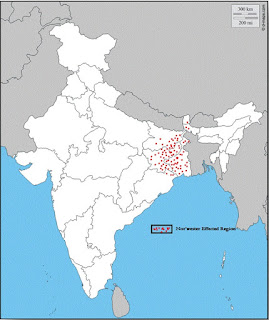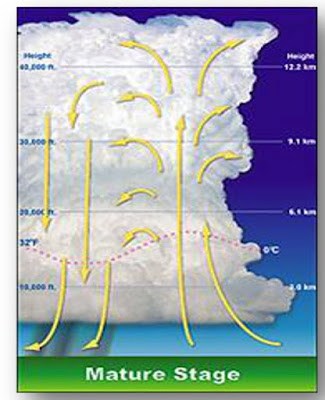INDIA
Indian climatology
Indian Geography
Indian physical Geography
Kalboishakhi
Local wind
Low Pressure
Nor'wester: Concept & Phase of Formation
Summer
West Bengal
INTRODUCTION:
Nor'wester: Concept & Phases of Formation
Sunday, September 10, 2017
INTRODUCTION:
 |
| Fig:1: Nor'wester Affected Zone of India |
Thunderstorms are one of the natural hazards which inflicts huge damage to the life and property and cause severe socio-economic impact in the affected region. (Yamane and hyoshi 2006). During the pre-monsoon season (march-may), the eastern and north eastern state of India like West Bengal, Assam part of Orissa. Jharkhand and Bihar experience the dramatic appearance of a special type thunderstorm known as nor-wester (Mishra 2006). This thunderstorm is predominantly from north-west direction and hence called nor-wester (Desai 1950, Kessler 1982). But over the Bengal, it is locally known as kalbaishaki or calamity that means calamity in the month of Baisakh (first month in Bengal calendar). Famous Bengali poet Mohitlal Majumdar described nor-wester so nicely in this poem “kalbaishaki” that a metrological can hardly do. This thunderstorm has become a familiar feature of the hot afternoon of March, April and May (now also injure). In Bengal increases towards March, April, and May, with the onset of monsoon March, April, and May, with the onset of monsoon, the occurrence of it decreases.(Mishra 2006). Norwester mesa scale convective system which can be developed under the large scale envelope of the seasonal. Low level through over the West Bengal, Bihar, Jharkhand belt with a possible embedded low-pressure area. (A.Srivastav, M.Kumar, and A.K.dwiveod.12).in India, 72% of tornadoes are associated with nor-westers. India has plans to conduct field experiments to understand this severe weather system, its genesis, their dimensional structure, temporal changes and damage potential. There severe thunderstorm associated with thunder, squall lines, lightning, torrential rain and hail cause extension loss in agriculture damage to property, and also loss of life apart from its destructive effects the rainfall associated with the storm although small in amount, is extremely helpful for the pre-kharif crop like jute, paddy, till, large number of vegetation and fruits and the sudden drop in temperature gives relief after unbearable mid-day heat. These severe thunderstorms have significant socio economic impact in the West Bengal and also eastern north eastern part of India.
CONCEPT OF LOCAL STORMS:
A Particular effort is made to wear of hail, lighting and wind guest associated with the severe thunderstorm. Sometimes called severe local storm S (SELS) or similarly severe weather. Forecasts and warning also are made for tornado or Nor’westers, those intense, rotting windstorm that represent the most violent end of the weather scale. Destruction of property and the rest of injury death are extremely.
GENERAL CHARACTERISTICS
1. This thunderstorm usually moves from north-west direction to south-east direction and therefore known as Nor’westers or in local terminology as kalbaishaki. (D.Pradhan, 2012).
2. This type of thunderstorm developed occurs due to the collision of two different kinds air masses, (i) dry land based air mass coming from north-west direction and (ii) moist hot maritime air mass coming from south or south-east. (P.chatterjee, D.Pradhan, U.K.De, 2008).
3. At approaches at first slowly and then more and more rapidly with a strong gust or squall.
4. There are frequent thunder and lightning following by downpour of rain and sometimes accompanied with hall, which is driven by the strong wind. On some occasion, the wind blows with almost hurricane force.
5. The thunderstorm is Bengal start as early as February. The number gradually increases maximum in April and May and decreases thereafter along with the onset of monsoon. (S.Mishra 2006).
6. On an average, the hot weather season experience is such thunderstorm of which March records, April and May almost 6 each. But the frequency is highly variable from one year to another year (S.Mishra, 2006).
7. Usually, the thunderstorm squalls occur in the afternoon and evening but they are also observed at other times of the day and night.
8. On the approach of the squall in general, the temperature drops and air pressure rises suddenly due to the pouring of cold air. Fall of temperature from 2⁰-4⁰c in very common but the fall even up to 12.5⁰c has also been recorded. (S.Mishra-2006).
9. The amount of rainfall from such squalls is highly variable from place to place and one squall to other. Over the Gangetic West Bengal, the amount of rain from such squall varies from less than a millimeter to more than 80 millimeters and increases from east to west.
Duration of such thunderstorm over a station varies from a few minutes to about an hour.
10. Nor’weaster occurrence is associated with cumulonimbus clouds, the base of which is as low as a half kilometer from the ground surface while their top frequency go up to 12 kilometers or event beyond.(S.Mishra 06)
11. These have a mesoscale structure with a very rapid development after associated with moderate/severe squalls achieving a speed in the range 130-150km/h, which may even reach tornados violence causing considerable damage to property and loss of life.(Ghosh et al.2008)
12. These severe thunderstorm associated with thunder, squall lines, lightning, torrential rain, and hail. The casualties report due to lighting associated thunderstorms in this region is the height in the world. In India, 72% tornados are associated with Nor’westers.
FORMATION OF NOR’WESTER:
In the summer month, the atmosphere becomes unstable due to intense isolation. On such day if there is a suitable synoptic situation such as surface low-pressure area over Jharkhand and adjoining district of Gangetic West Bengal. The cyclone vertically reaching up to 1.5km above sea level with day air aloft and pressure of a jet stream between the levels 300 mb and 200 mb in the vicinity of Gangetic West Bengal are extremely helpful for the Occurrence of Nor’Westers. There are five Phases of Nor’wester formation, these are-
Phase-1
On such day if there is a suitable synoptic situation such as a surface low-pressure area over Gangetic West Bengal in this time due to collision of two different kinds of air masses-
a) Dry Land based air mass coming from north-west(NW) direction of India
b) Moist Hot malting air mass coming from South or South-East of India or Bay of Bengal.(P.Chatterjee, D.Pradhan, UK.De,2008)
PHASE:-2
After the flowing two different air masses, the moist and dry air mass there is an ISOTHERMAL REGION or REGION OF CONTRAST. There should be a westerly or north-westerly dry air mass with a fairly high lapse rate flowing over the moist southerly air (Nandi.P, Mukhopadhyay, M, 2011).The warm, moist, southerly low-level flow from the Bay of Bengal and a cool, dry westerly or NW upper-level flow existing over the region gives rise to a favorable synoptic setting for the formation of Nor’westers. (Tyagi.B et al 2010).
In this time distribution of air mass gives rise to latent instability condition over Bengal due to sun heating on the land, local low-pressure cell worm and humid air mass rises condition point is recharged within 15 minutes, the tops of Cumulus cloud, surge upward to altitude of 8000 to 10000m, because of the release of latent heat. This instability is always manifested but may exist in a latent state and this only requires a further impulse for the energy to be released sometime with great violence this impulse is known “TRIGGER MECHANISM”.This trigger mechanism help to raise the moist underlying air up to
PHASE:-3
Phase-4
Insolation which reaches its maximum in the afternoon and causes large conventional updraft of air from the lower to the higher level of the atmosphere. As a result of this process, the Nor’Wester or Thunderstorm of Bengal mostly occur.
There are frequent Thunder and lightning followed by a downpour of rain and something accompanied with hall, which is driven by the strong wind. On some occurrences, the wind blows with almost hurricane force. (Mishra.S 2006).Sudden rise the wind speed, drop in temperature, the rise in air pressure due to the pouring of cold air, thunder, lightning, hail, rainfall is the well-known features of Kalbaisakhi. Temperature decreases up to 2°c-4°c generally. Even up to 12.5°c has also been recorded. (Mishra.S 2006)
➽ Drop late large enough to overcome the resistance of updraft (Rain/hail).
➽ “Entrainment” Drive air is drawn in.
➽ Air descends in downdraft due to evaporating cooling and falling rain/hail.
➽ “Anvil “head when stable layer reached.(Cloud follows horizontal wind ).
➽ Strongest stage, with lighting and thunder.
Phase-5
Thereafter with the onset of Monsoon, their frequency and violence decrease considerably. (P.K.Sengupta).
At the lasts tag the updraft weaken as gust front moves away from the storm. During the Dissipating stage subsiding air replace the updraft throughout the cloud, effectively cutting off the supply of moisture by the updraft. Adiabatic compression warms the subsiding air, the relative convective clouds gradually vaporize.
⇛ END ⇚
LIKE OUR FACEBOOK PAGE- GEOGRAPHY (CLICK HERE)
Previous article
Next article





